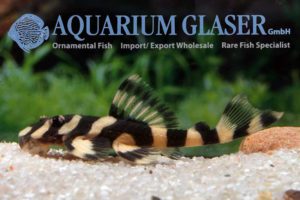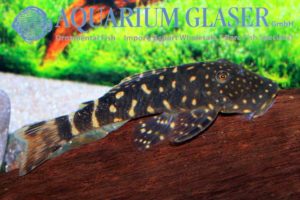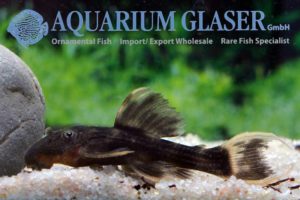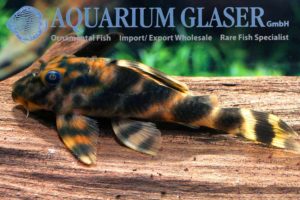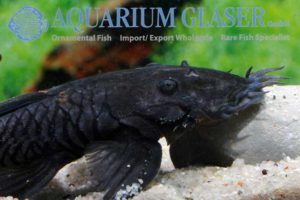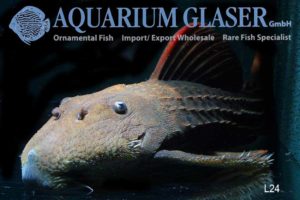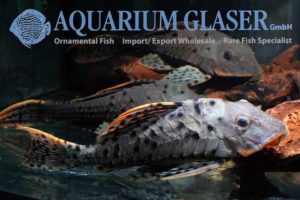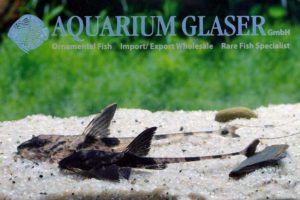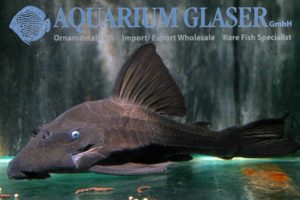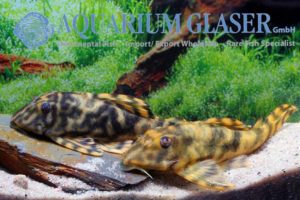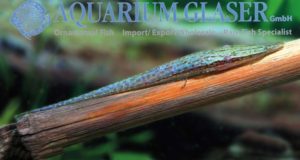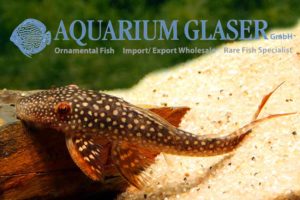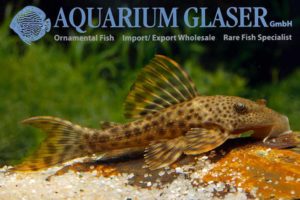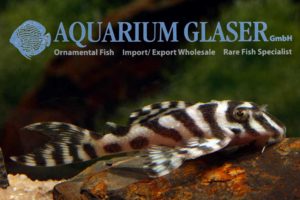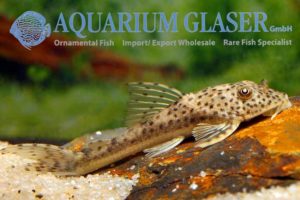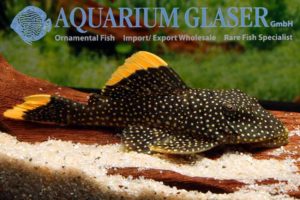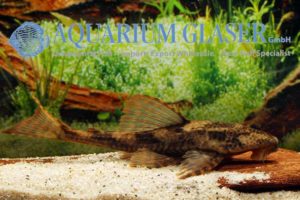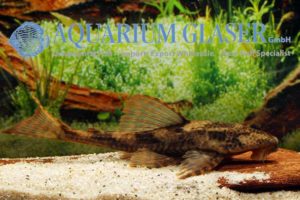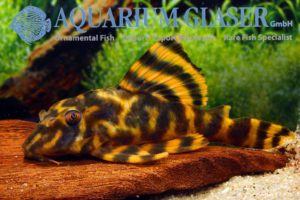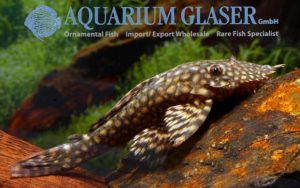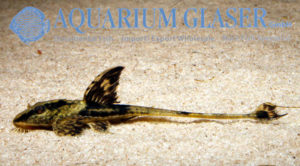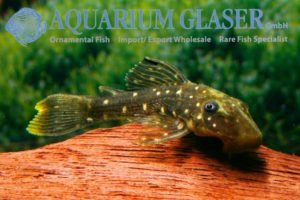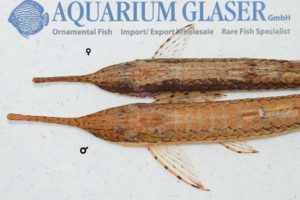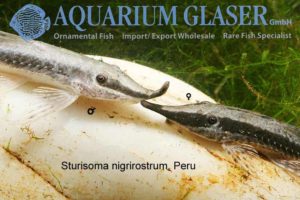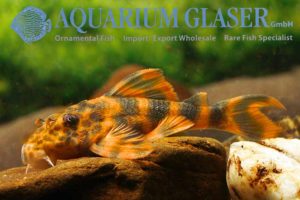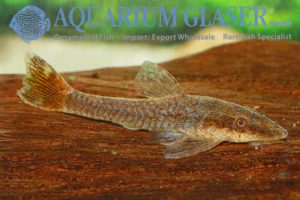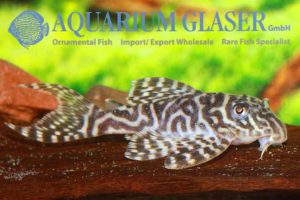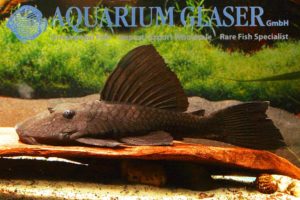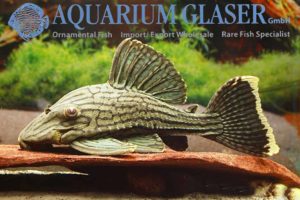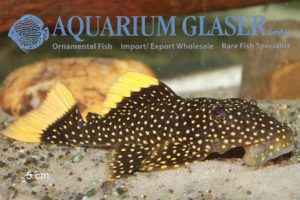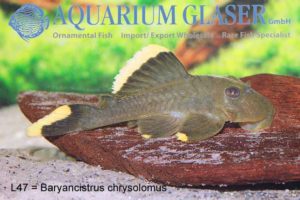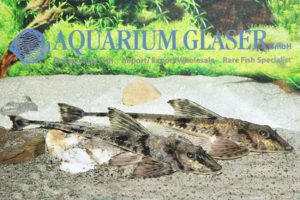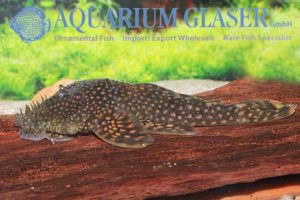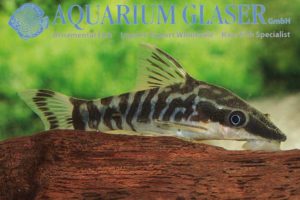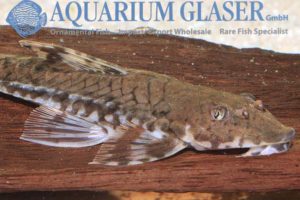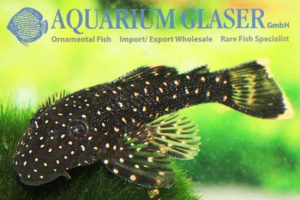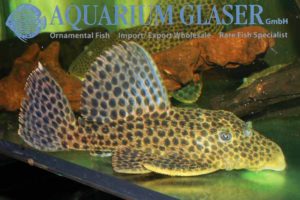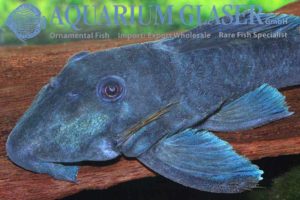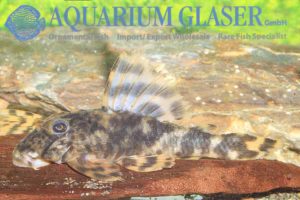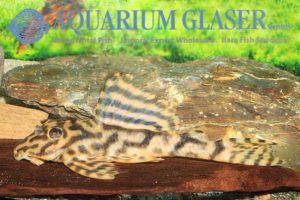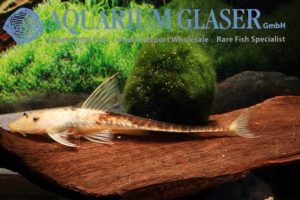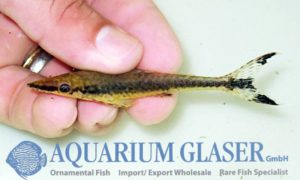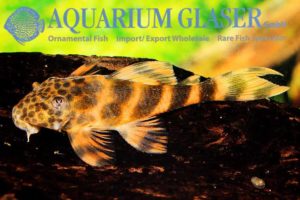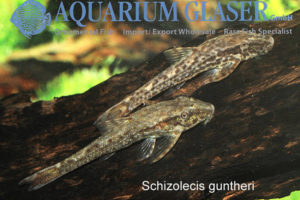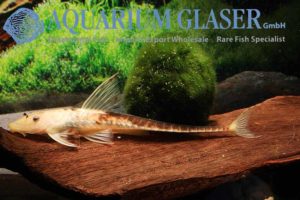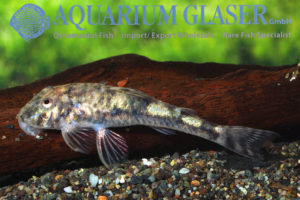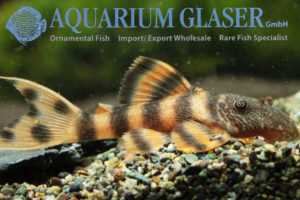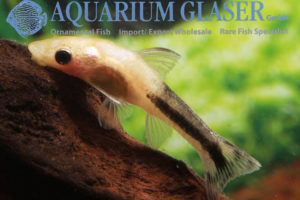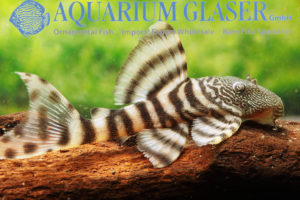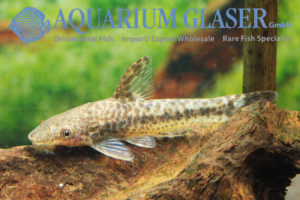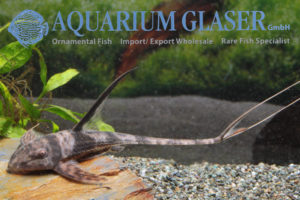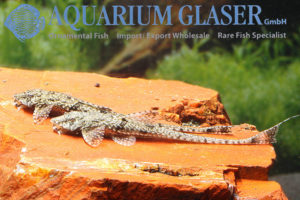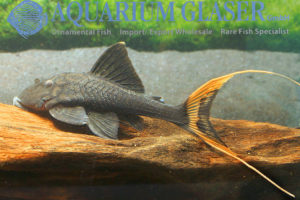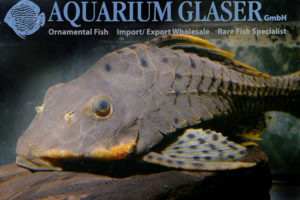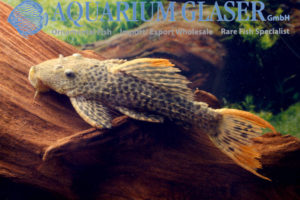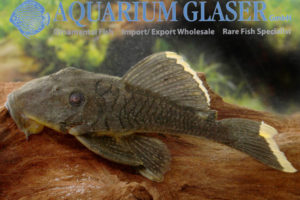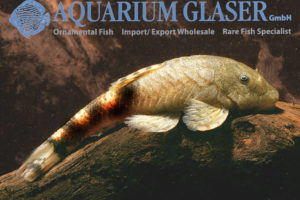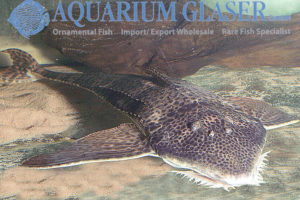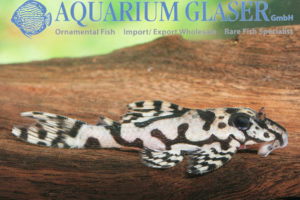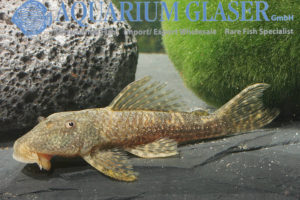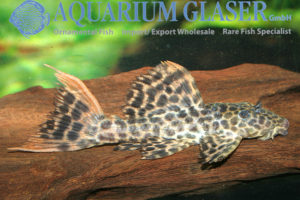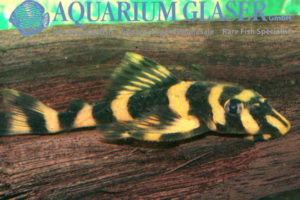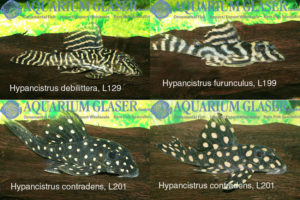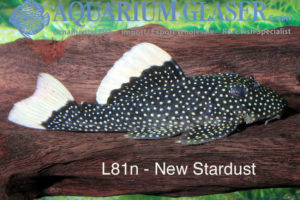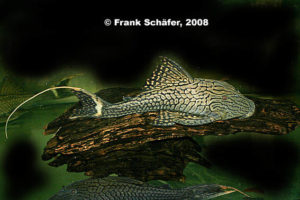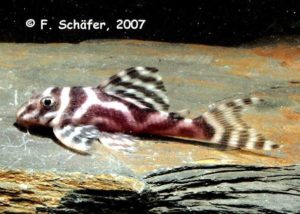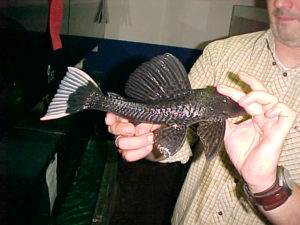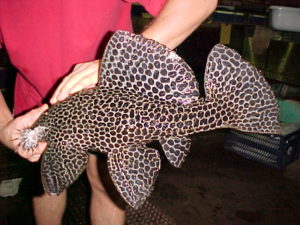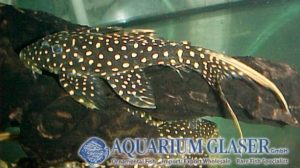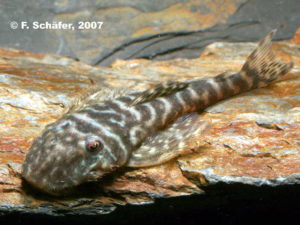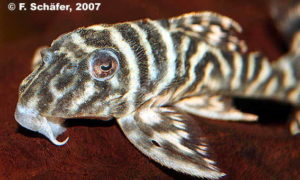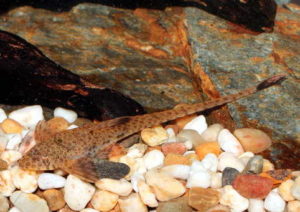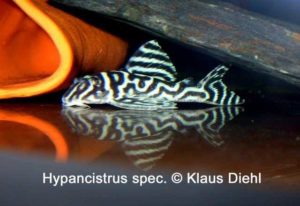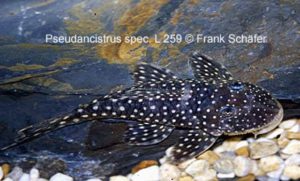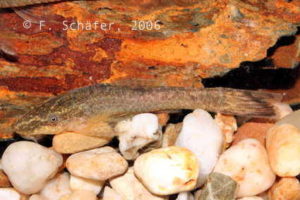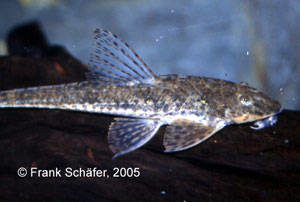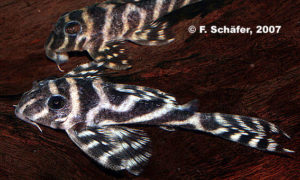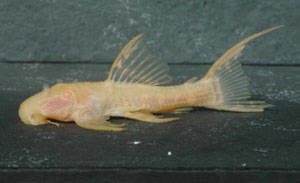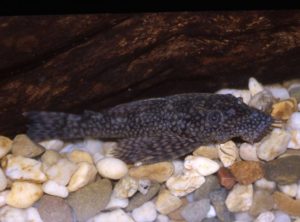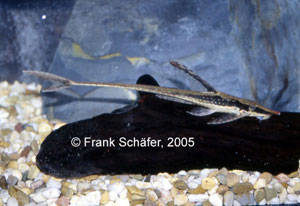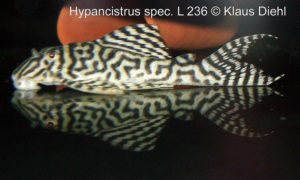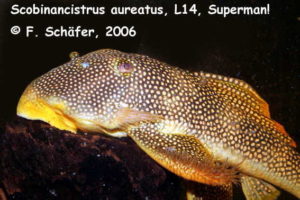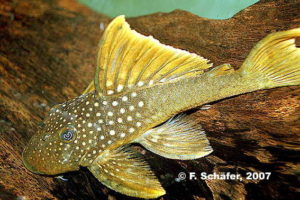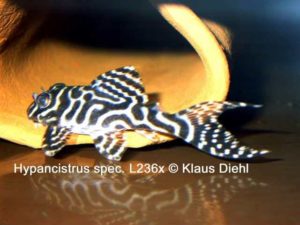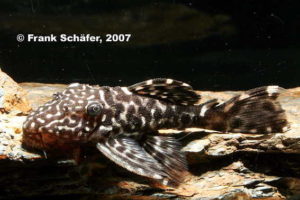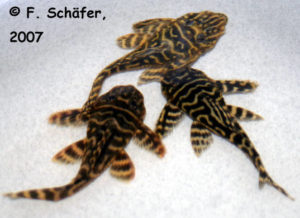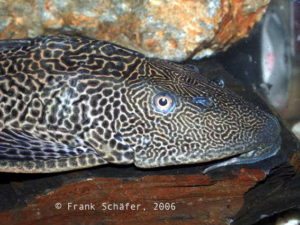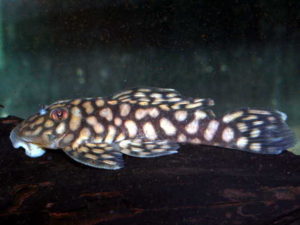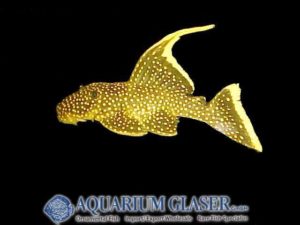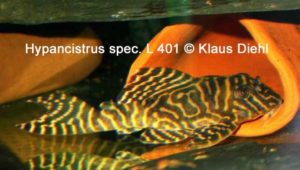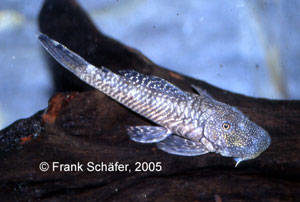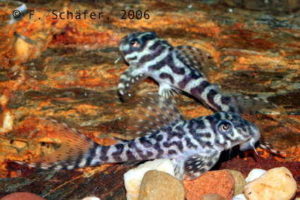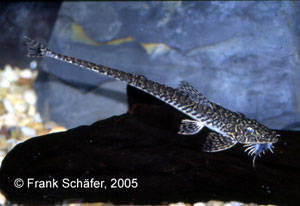Once more we received very pretty bred L168 from our proofed breeder. Currently the fish are 4-5 cm long. The scientific name of the species is Zonancistrus brachyurus. The wrong name “Peckoltia pulcher”, however, still often appears on the stocklists. For our customers: the animals have code 26480-L168x-1 on our stocklist. Please note that we […]
10b. Catfishes: Suckermouths, Plecos and L-numbers (318)
-
-
L455 Chaetostoma sp. Tiger
Finally we were able once more to import the wonderful Chaetostoma sp. Tiger from Peru. This is our second importation since 2011. Due to the fact that we offered the first specimens long before they attained a L-number they formerly had the codenumber 214844 on our stocklist. Now they have 26480-L 455-4 (5-7 cm) and […]
-
L25 Pseudacanthicus sp. Scarlet: German bred babies!
L25 “Scarlet” is still one of the most sought after large loricariids. Now we can offer for the first time ever German bred specimens of this beautiful species which are currently 4-5 cm long. For our customers: the animals have code 26480-L 25X-0 on our stocklist. Please note that we exclusively supply the wholesale trade. […]
-
Peckoltia sp. L202
We received very nice coloured L202 from Colombia. This species of Peckoltia has the additional L-numbers LDA 57 and LDA 79. The fish attains a maximum length of 12-14 cm. They should be kept at temperatures of about 25-29°C. For our customers: the animals have code 26480-L 202-2 on our stocklist. Please note that we […]
-
L34 Ancistrus ranunculus
Once more we were able to import one of the flattest species of L-numbers: Ancistrus ranunculus (L34). In any case it is the most emancipated of all, because in this species also the females wear a pretty large beard! For our customers: the animals have code 26480-L 034-3 on our stocklist. Please note that we […]
-
Huge range of large Pseudacanthicus in stock!
Currently we can offer several species of the magnificent Pseudacanthicus in show size: L24, Pseudacanthicus serratus, 30-35 cm, only one specimen available, code 26480-L 024-8 on our stocklist L25, Pseudacanthicus sp. Scarlet, 30-35 cm, only one specimen available in that size, code 26480-L 025-8 L25a, Pseudacanthicus sp. Sao Felix, 30-35 cm, also only one specimen […]
-
Pseudorinelepis sp. L 95
Once more we were able to import another catfish gem: L95, a scientifically undescribed species of the genus Pseudorinelepis, which is very closely related to P. genibarbis. Our specimens come from the Takutu river in the upper Rio Branco basin. These gorgeous fishes are collected mostly in relative large specimens, because the juveniles are not […]
-
Loricaria simillima bred
We received charming German bred specimens of this mouthbreeding whiptail catfish. Just like the parents the offspring shows a great variability regarding coloration. For our customers: the animals have code 266651 on our stocklist. Please note that we exclusively supply the wholesale trade. Available in limited numbers only! Text & photo: Frank Schäfer
-
Panque suttoni
The Blue-eyed Panaque was in the 1980ies one of the most common loricariids in the trade. By the way: the correct scientific name is Panaque suttonorum. For unknown reasons the fish is hardly available nowadays. There are, however, a lot of rumours. Some say that an ecological catastrophe appeared, others tell that a madman has […]
-
Peckoltia sp. Alto Nhamunda
For the first time ever we could import this attractive dwarf suckermouth catfish. The maximum length observed was about 14 cm. The males – they can be easily recognized by the long “whiskers” – have a very obvious different colour compared with the females. For our customers: the animals have code 277334 on our stocklist. […]
-
Acestridium dichromum arrived!
We received once more the very rare dwarf suckermouth catfish Acestridium dichromum from Venezuela. The species attains a length of 5-6 cm only. The species could be called “chameleon dwarf sucker cat”, for it becomes bright green when sitting on plant leaves, but changes colour to brown within a few days when only roots and […]
-
Lasiancistrus heteracanthus
We were able to import the rare Red-eyed Deltatail-suckercat, Lasiancistrus heteracanthus, in small numbers from Peru. The species attains a total length of 15-18 cm. Besides the bright red eye the most striking feature of the species is the pretty brown-red lower lappet of the caudal fin. Lasiancistrus, in general, are good algae-eaters and fit […]
-
Hypostomus sp. Bolivia Redfin
In the Mergus Welsatlas, Vol.2, page 1110 the authors H.-G. Evers and I. Seidel illustrate a pretty Hypostomus originating from Bolivia. The determination of the species was not possible yet. The species reminds one strongly of L231 from Peru, but the new pleco from Bolivia has nice orange-reddish seams in the fins. We currently received […]
-
Hypancistrus sp. L236 bred
Zebra plecos from the Rio Xingu and its affluents are banned for exportation for years already. Even at the times when a legal exportation was possible, L236 from the Rio Iriri (an affluent of the Xingu) was extremely rare and only few specimens were caught per year. The specimens we currently have in stock are […]
-
Aphanotorulus frankei Bolivia
The genus Aphanotorulus contains only two species, following some scientists: A. ammophilus from the Orinoco basin and A. unicolor from the complete upper Amazon basin. However, aquarists are by far more splitting in this respect and distinguish at least four different species, among them A. frankei from Peru. We now received a shipment Aphanotorulus from […]
-
A new Golden Nugget
The Golden Nuggets (L18, L81, L81n, L177) belong to the genus Baryancistrus and have been described scientifically under the name of B. xanthellus. However, it is still unclear wether all these forms belong to the very same species or if they represent close relatives, but seperate species. For the differences, please see http://www.aquariumglaser.de/en/baryancistrus-l18,-l81,-l81n,-l177_de_1072.html Now we […]
-
Hypostomus ancistroides
This extraordinary, very slender species reached us from Paraguay. Maximum length reported is around 25 cm. This is a subtropical species and thus it is possible to keep it in an unheated indoor-tank. This is a very rare species and even we are able to offer it only very frequently and in limited numbers. For […]
-
Hypostomus ancistroides
Once more we were able to import this extraordinary slender, very rare Hypostomus from Paraguay. The subtropical species tolerates temperatures between 16 and 28°C and attains a maximum length of about 20-25 cm. For our customers: the fish have code 262454 on our stocklist. Please note that we exclusively supply the wholesale trade. Available in […]
-
Peckoltia sp. Red Tiger
For the fitrst time ever we could import this extremely attractive Peckoltia from Brazil. The animals are 10-12 cm long and obviously sexually mature already. Available in very limited numbers only! For our customers: the fish have code 277313 on our stocklist. Please note that we exclusively supply the wholesale trade. Text & photos: Frank […]
-
Ancistrus sp. L89 wild
We received wild collected specimens of one of the most sought-after for species of Ancistrus from Brazil: the pretty L89 from the Purus. In L89 the nice “honeycomb-decor” stays life-long, whereas in most other similar species of Ancistrus this pattern becomes more and more dark during life. Available in limited numbers only! For our customers: […]
-
Loricaria sp. Colombia BRED
For the first time ever we received German bred specimens of this attractive, mouthbrooding whiptail cat. The species is still undescribed scientifically, attains a maximum length of about 20 cm and is characterized by its unique harness stripes. For our customers: the fish have code 266621 on our stocklist. Please note that we exclusively supply […]
-
Hypostomus luteus – bred ones available!!!
We are currently in the lucky position to be able to offer the only existing bred specimens of this gorgeous sucker cat from the south of South America. The specimens have a size of 3-4 cm. We enclose some pics of adults we imported in 2009 from Agentina to give a reminder what will become […]
-
Farlowella oxyrrhyncha
For the first time ever we received this extreme sharp nosed needle sucker in very limited numbers from Peru. For our customers: the fish have code 253864 on our stocklist. Please note that we exclusively supply the wholesale trade. Text & photos: Frank Schäfer
-
Sturisoma arrived!
We received gorgeous, large Sturisoma robustum from Paraguay and the quirky S. nigrirostrum from Peru. In the Peruvian Whiptail S. nigrirostrum the male developes an upturned “nose”. The sense of this feature is unknown. For more information on S. robustum, please click http://www.aquariumglaser.de/en/fish-archive/catfish-en/loricariidae-en/_en-3/. For our customers: Sturisoma robustum has codes 294874 (12-15 cm) and 294875 […]
-
Farlowella platorhynchus
The needle suckers (Farlowella) belong to the most specialized Loricariids at all. Their whole life is dedicated to the trick to look like a stick. Currently we received fantastic, up to 18 cm long Farlowella platorhynchus from Peru. There is a lot of variation observable regarding coloration. Males and females can be distinguished best by […]
-
Ancistomus sp. L387 “Orange” – young adults in stock
The wonderful L387 is only very occasionally available. Currently we have young adults of 5-7 cm length in stock (females are smaller than the males). Our animals are German bred ones. For more information, please check http://www.aquariumglaser.de/en/ancistomus-sp-l387—beautiful-bred-ones-available_en_1284.html Text & photos: Frank Schäfer
-
Hisonotus nigricauda
For the first time ever we were able to import this charming dwarf catfish from Paraguay. The species looks quite similar to the well known “Otocinclus Negros” (the correct specific name of that fish is Otothyopsis piribebuy) and can be kept the same way. The most obvious difference between the two species is the coloration […]
-
Hypancistrus sp. L400
Code 26480-L400x-2
-
L261a – Ancistrinae gen. sp.
This species of fish is among the rarest of all L-numbers. It belongs not only to none of the species described so far, but also cannot be applied to any described genus. L261 was imported initially from the Orinoco in Venezuela. The individual we were able to import now for sure belongs to the same […]
-
Panaque sp. L418 Shampupa
The magnificent Panaque species which belong to the P.-nigrolineatus-complex are much sought for ornamental fishes. All species seem to become around 40 cm long. One of the most spectacular ones originates from Peru and received the L-number 418. Characteristic features of the fish, which is called Shampupa by the exporters, is the broad light band […]
-
Baryancistrus sp. L81n
We take the opportunity of the receipt of a larger shipment of L81n and the scientific description of Baryancistrus xanthellus (L18, L81, L85, L177, see http://www.aquariumglaser.de/en/news/l18_l81_l85_l177_and_l47_described_scientifically_en/) to take a closer look on L81n, which we get from Sao Felix do Xingu, once more. As in all ancistine catfish it is also true in L81n: the […]
-
L18, L81, L85, L177, and L47 described scientifically
These plecos, which originate from the Rio Xingu and its tributary Rio Iriri belong to the most popular L-numbers. Now they have been described scientifically. L18, L81, L85, and L177 belong to the same species (although L81 has not been mentioned in the paper) and have been named Baryancistrus xanthellus, whereas L47 has been named […]
-
Loricaria simillima from Paraguay arrived
Beautiful wild collected specimens of this mouthbrooding whiptail cat arrived right now from Paraguay. Read more about this fish here: http://www.aquariumglaser.de/en/fish-archive/catfish-en/loricariidae-en/Loricaria_simillima_en/
-
Ancistrus sp. L309
Finally we were able once more to import this very nice and unique member of the specious genus Ancistrus: L309. The species has not been described scientifically yet and originates from the Rio Tapajós. The fish is so different from the other members of the genus that is was even thought at times that it […]
-
Otocinclus cocama
The dwarfish catfishes of the genus Otocinclus are usually kept due to their algae-eating activities and their nice behaviour. The coloration of most of the species is only rather dull. Otocinclus are very famous for cleaning especially the waterplants without hurting them. Could it be that there exists a species that is not only very […]
-
Hemiloricaria castroi
It was in August of the past year (2010) that we posted a notice on the successful importation of a wild collected lutiono of Hemiloricaria from Peru (http://www.aquariumglaser.de/en/hemiloricaria-sp-golden-lutino_de_1209.html). The animal is still living in our facility (May 2011) and has changed its coloration completely as can be seen on the new photos. Moreover, now it […]
-
Ancistrus sp. L180 – wonderful German bred ones available
The Ancistrus species which has the code L180 is only very occasionally imported from Brazil. Obviously there is a number of very similar species existing. In AqualogNews 98 (will appear in May 2011) they will be portrayed in detail. Ancistrus sp. L180 belongs to the yellow-white spotted species of Ancistrus. Currently we have beautiful German […]
-
L234a – a new Megalancistrus
The genus Megalancistrus comprises currently only two accepted species, namely M. barrae from the Rio Sao Francisco and M. parananus, which is distributed in the triangle between Argentina, Brazil, and Paraguay. Two L-numbers have been given to M. parananus: L113 and L234. The species belongs to the largest species of Loricariids at all and can […]
-
L 239, Ancistrinae gen. sp. Blue
We received a shipment of this very nice Pleco from Venezuela. The species becomes only 10-12 cm long. The blue iridescent fins look extremely attractive, but also the remaining parts of the body are blue-blackish coloured. It was not possible so far to place the species in an existing genus and also the species seems […]
-
Peckoltia sp. LDA61
We received this nice pleco from Colombia. It is one of the most undemanding plecos at all. The species reaches about 12 cm maximum length. This species has such a variable coloration that a lot of L- and LDA-numbers were given to it. The animals imported now with the additional name “Morruda” (spanish, means “blobber-lipped”) […]
-
Ancistomus sp. L243/LDA86
Recently we received the very nice, only rarely imported species of Ancistomus, which was given the numbers L243 and LDA86, respectively. The species is not described scientifically yet. Like most Ancistomus the species reaches a maximum length of about 15-20 cm and is thus a medium sized species of the family. Ancistomus feed mainly on […]
-
Hemiloricaria sp. 2-color/lutino
Code: 257924
-
Hypoptopoma sp. “New Tricolor”
Only limited number available. Code: 262322
-
Ancistomus sp. L387 – beautiful bred ones available!
The loricariid catfish L387 is imported only occasionally and in small numbers from Colombia and Venezuela. This is due to the fact that obviously another, easily available and (at least in juvenile stages and fright coloration) very similar species occurs where L387 lives: L147. So we get wild collected L387 only as so-called by-catches. Initially […]
-
Schizolecis guntheri and LG4
The coastal rainforests of southeastern Brazil are the home of a good number of unusual aquarium fish. One of the most popular and most attractive species from that region is for sure Scleromystax barbatus, the Bearded cory (formerly known as Corydoras b.). Sadly the natural habitats in that region are much affected by the growing […]
-
Hemiloricaria sp. Golden (Lutino)
This wild collected specimen from Peru has a very unique colour aberration. Usually such specimens cannot survive in the wild, but this fish is a healthy, adult animal. For our customers: the fish has code 257924 on our stocklist. Please note that we exclusively supply the wholesale trade. Lexicon: Hemiloricaria: ancient Greek, means “half loricaria”; […]
-
Parotocinclus jumbo, LDA 25, Pitbull Pleco
The import season for this charming algae killer has started. Parotocinclus jumbo is both one of the largest species of the genus (maximum size is reported to be around 6-7 cm!) and one of the prettiest. Astonishingly there is so far no report in the aquarium literature on the very obvious sexual dichromatism found in […]
-
Panaqolus sp. PUCALLPA
Once more we were able to import another quite cute suckermouth catfish from Peru – from Pucallpa to be more precise. Again, this species belongs to the closer Panaqolus changae relationship (LDA 26, L206, L226), as it does the “New Zebra Pleco” we introduced to you last week (http://www.aquariumglaser.de/en/news/Panaqolus_sp_NEW_ZEBRA_JUTAI_en/). Especially the young ones are colored […]
-
Otocinclus vestitus PARAGUAY
The season for this popular Otocinclus has started now. Otocinclus vestitus has a very large distribution. It is found in Peru, Bolivia, and Paraguay. The species can be easily identified by the typical pattern in the caudal fin. Among the O. vestitus we received this week from Paraguay was one very unusual xanthoristic specimen. It […]
-
Panaqolus sp. NEW ZEBRA JUTAI
This extremely attractive new suckermouth cat was sent to us from Peru with the name of a collecting site “Jutai”. Currently the fish are around 4-6 cm long. There is no doubt that they belong to the Panaqolus changae group (LDA 26, L206, L226). A very astonishing matter in these fish is the fact that […]
-
Otocinclus mimulus
For the first time ever we are now able to offer a very rare Otocinclus species, namely O. mimulus. Besides all the well known good characteristics that it shares with other members of the genus – small size, peacefulness, cleaning of plant leaves, day activity – this species also has to offer a very special […]
-
Lamontichthys llanero
This beautiful catfish comes from Venezuela. Lamontichthys are very sensitive and need extremely clean water. Another problem is that they often refuse food. This is obviously a problem due to the shyness of the fish. Even relatively small disturbances let them stop feeding for hours. This is the reason why Lamontichthys are kept best in […]
-
Hemiloricaria beni
Now we can offer the smallest known species of whiptail catfish: Hemiloricaria beni. It hardly becomes longer than 8 cm. As this species occurs only in Bolivia and no commercal exportations from Bolivia appear, we offer only bred ones. Initially Swiss aquarists collected this species on a private collecting trip in 1997. Since then a […]
-
Panaque L90a Ojo Chico
L90 is a very variably colored species. This year we received very nice animals which have the bright halfmoon in the caudal fin orange red instead of white. The Spanish name (ojo = eye, chico = boy) does not emphasize on the coloration, but on the small eye which distinguishes L90 from other members of […]
-
Pseudorinelepis sp. L95
Last week we were able to import another catfish gem: L95, a scientifically undescribed species of the genus Pseudorinelepis, which is very closely related to P. genibarbis. Our specimens come from the Takutu river in the upper Rio Branco basin. These gorgeous fishes are collected mostly in relative large specimens, because the juveniles are not […]
-
Pseudacanthicus leopardus
The genus Pseudacanthicus currently comprises five described species. Three of them are known as aquarium fish. Additionally there are 16 L-numbers given for species of Pseudacanthicus which represent either species new for science or have a doubtful identity. Species of Pseudacanthicus are also known under their popular name “cactus catfish”, for the species are very […]
-
A new L-catfish!
Last week we were able to import a new yellow seam pleco belonging to the genus Baryancistrus. The fish originate from Sao Felix at the Rio Xingu. They differ from all other members of the genus from there (L18, L47, L81, L85, L177) by the almost black ground colour of the body. Almost no spots […]
-
Lampiella gibbosa
This charming little catfish species was described as early as 1908 by Miranda Ribeiro under the name Otocinclus gibbosus. But only when a group of reseaching aquarists (H.-G. Evers, M. Lacerda, and M. Beyer) managed to cellect the fish alive it became clear, how distinct from all other Otocinlus-like fishes this species really is. There […]
-
Loricaria lentiginosa
For the first time ever we were able to import one of the largest species of Loricarai, namely L. lentiginosa. The magnificent animals are about 40 cm long and thus fully grown. Like in all species of Loricaria they are paternal mouthbrooders. The male transports the eggs that stick together with its moutn until they […]
-
Hypancistrus L236xx
The Brazilian species of the genus Hypancistrus are currently not allowed to be exported from the country. Thus L-numbers of this genus, like L236 from the Rio Iriri, are available as bred specimens only. Among the last brood we received was one extraordinary specimen, which is depicted here. Text & Photo: Frank Schäfer
-
A new pleco from the Rio Sao Francisco
The Rio Sao Francisco is a large river in southern Brazil. It´s length is around 3.200 km. The ichthyofauna of the Sao Francisco is comparably good explored, as there plans for an irrigation project. So the environment has to be explored and there were and are several studies on the fish fauna. We currently received […]
-
Just in: L114
After some time we were able now to import again L114. It is a member of the beautiful Pseudacanthicus-leopardus species group. The members of this species group can reach 25-30 cm total length, some sources give even 40 cm. They originate from the Rio Negro basin near Barcelos in Brazil. They are omnivorous, but prefer […]
-
Wonderful German bred Zonancistrus pulcher (L168) arrived!
Photo: Frank Schäfer
-
Import season for Orinoco-Plecos has startet!
The Rio Orinoco is with more than 2.000 km length one of the biggest rivers of South America. About 3/4 of it´s length it runs through Venezuela, the remaining 1/4 belong to the territory of Colombia. The Brazo Casiquiare connects during high water levels the Orinoco-sytem with the Amazon-sytem via the Rio Negro. The import […]
-
Baryancistrus L18, L81, L81n, L177
The main collecting season of the beautiful gold seam sucker cats of the genus Baryancistrus starts around end of may and lasts until the end of september. Although these fishes are common in the wild, live in shallow waters and are traditionally used as food fish, they cannot be connected with one of the about […]
-
L90 Panaque var.JUANJUI
Last week this very attractive variant of L 90 arrived from the vicinity of Juanjui (Peru). They are very intense light-dark patterned fishes with glowing red eyes . The white filaments of their caudal fin give them an additional elegance. Feeding with special food (shrimps, or red discus food)can change fin colors to a strong […]
-
Hypancistrus spec. L 173b
(19.Feb.2008) After a long break back in our stock: German offspring of L 173. This very rare Hypancistrus is probably the most closely with L 46 related species. As juveniles they look like zebras with an irregular stripe pattern. Their final size is a little larger than L 46 L also their clutches are larger. […]
-
Hypostomus isbrueckeri
(28.Nov.2007)At the moment we have a group of nearly full-grown Hypostomus isbrueckeri in stock. The here pictured male is easily distinguishable from its partners by the bright colors of the caudal fin. This is probably the only Loricariid species which shows such a pronounced gender difference. Their origin is the border region Brazil, Argentina, and […]
-
Megalancistrus parananus L234
-
Pseudacanthicus spec. Typhoon
(2nd.Nov.2007) For the first time we can offer Pseudacanthicus spec. Typhoon. This extremely attractive Cactus Pleco comes from Brazil, its origin is kept as a secret, so that no information concerning the river were they have been caught can be made. In the appearance they reminiscent of Pseudacanthicus spec. “Titanic” L 273, the colour (black […]
-
Ancistrinae spec. L 189
Several adult specimen of L 189 the wormline – Orinko catfish arrived with an import of L 257 Pseudolithoxus tigris. On this shown male, the odontodes on the head, breast and ventral fin are clearly visible, that absolutely states a belonging in the Pseudolithoxus group. Puberty is approximately reached at 7 cm, it’s end size […]
-
Hypancistrus spec. Xingu
From lower parts of the Rio Xingu we received very high-contrasted Hypancistrus spec. Xingu. In their appearance they arrange between L 333 and fishes of the L 66 group. But they are clearly more flattened and stretched than L 333. From L 66 and their relatives (e.g. L 236) they can be distinguished by the […]
-
Rineloricaria melini
As a further german bred rarity we can offer Rineloricaria melini at present. Our specimen of the probably most attractive Rineloricaria species have with 9 – 12 cm length already attained full growth and are of outstanding quality. Their origin is the area of the Rio Negro where they live in black water biotopes. Like […]
-
Hypancistrus spec. L 173
March 2005: Freshly arrived: Beautiful German breds of L 173. For the first time we can offer thereby more than a “handful” of these wonderful rare pieces. The large variability of their pattern is remarkable. The bluish glow is common in all the white of their fins. (Photo & Text K. Diehl)
-
Pseudancistrus spec. L 259
Pseudancistrus spec. L 259 originates from the surrounding of the city Pimental at the Rio Tapajos. As all Pseudancistrus species the males of L 259 show a characteristic “beard” of Odontodes (dermal teeth) during the spawning season. Contrary to the popular Hypancistrus species L 259 are vegetarians. Therefore Zucchini, cucumbers and further vegetables should be […]
-
Hisonotus notatus
July 2006 From southeast Brazil we could import some rare pieces from the relationship of the popular Otocinclus species. In its homeland Hisonotus ornatus inhabits with weeds infested waters. It may not be kept too warm. 24°C probably represents the reasonable upper limit. The requirements for their maintenance do not differ from those of the […]
-
Rineloricaria sp. „Colombia“
A remarkable species which came in in one of our import from Colombia. These fishes also originate from the Rio Chacu in the northern tip of the country. Because of the many bristles of the male this species has been falsely determined as Rineloricaria latirostris. A comparison with the pictures (see Mergus Catfish Atlas Part […]
-
Hypancistrus spec. L 173 Bred
March 2007: Freshly arrived: Beautiful German breds of L 173. For the first time we can offer thereby more than a “handful” of these wonderful rare pieces. The large variability of their pattern is remarkable. The bluish glow is common in all the white of their fins. (Photo F. Schäfer, Text K. Diehl)
-
Pseudoacanthicus spec. „Albino Titanic“ L 273
April 2005: Only one fish of the albino form of the well-known „Titanic Catfish“ was imported from Belem (Brazil). L 273 is normally extremely variably coloured from fish to fish. As well as splendid specimens with contrasting dark grey/yellow plus orange colouration there are also individuals that are predominantly mouse grey with black dots and […]
-
Ancistrus spec. L 111
This ancistrus, which supposedly originates from Colombia, exhibits similarities to L 89, but like L 156 has round spots arranged in a honeycomb pattern. Unlike these other two L-numbers, L 111 has a uniformly marked iris ring and light/dark grey striped pectoral fin spines. This catfish is said to grow to about 10 cm, and […]
-
Sturisoma sp. „Colombia“
This for science unknown species was imported with a unique shipment from Colombia. Sturisoma sp. „Colombia“ was found in the Rio Chaco in the North of Colombia. This elegant Sturisoma species differs from the short finned species, which live on sandy habitats as well as from Sturisoma festivum by difference in colouration and body form. […]
-
Ancistrus spec. L 352
Our photo shows a pair of Ancistrus spec. L 352, one with 6 – 7 cm very small remaining loricariid from the Rio Iriri. In the view from above the different body forms can easily be be recognized. This and the characteristic beard of the males makes a differentiating of the sexes quite easy. As […]
-
Hypancistrus spec. L 236
„Simply the Best “: Some days ago we could import some of this beauties. With a size of approx. 10cm the white of the here illustrated male shows a fantastic intensity. It seems that one of imported fishes is a not less beautiful female, and so we hope to be able to offer some days […]
-
Scobiancistrus aureatus L 14
December 2006: Last week received we a really impressive, male Scobiancistrus aureatus. With a length of about 30 cm it might be attained full growth. The strong spines on the gill cover (Interopercularodontodes), as well as on their pectoral fins are remarkable. As most L-catfishes from the Rio Xingu they like warmer waters, for their […]
-
Baryancistrus demantoides L 200 High Fin
From Colombia we could import expressed beautiful L 200 High Fin. Now we have very attractive partially completely yellow colored specimen of the species Baryancistrus demantoides in stock. They will get only about 15 cm long and remain thereby substantially smaller than the also with the number L the 200 labeled Hemiancistrus subviridis. Compared with […]
-
Hypancistrus spec. L 236x
November 2006: At Christmas we would like to present a star at the catfish heaven. We can offer some offspring of the queen imperial zebra Hypancistrus spec. L 236x, a beautiful and very looked for species. They come from a German breeder, who had the luck that the two from us imported animals formed a […]
-
Leporacanthicus sp. „NEW“
April 2007: We received a particularly beautiful easter surprise this week from Colombia. The representative of the genus Leporacanthicus illustrated here is probably the first and only specimen on the market. It reminds of the in the Orinoco occurring L 240 and L 241, as well as of Leporacanthicus cf. “Venezuela”. But its white spots […]
-
Hypancistrus spec. L 340
Freshly arrived from Colombia: the Megaclown L 340. We can offer one of the most beautiful and at the same time most variable Hypancistrus “species” in very good quality. The animals already reached maturity, so that the outstanding contrast should remain. In their requirements for maintenance they do not differ from their Brazilian cousins, warm, […]
-
Liposarcus pardalis
Liposarcus pardalis has enormous area of origin that enclosure nearly the entire Amazon basin. It is found in different waters types, herefrom results a large adaptability for the maintenance in aquaria. According to the size (> 40cm) enormous food quantities are consumed. In Southeast Asia they are bred in large numbers and so wild caughts […]
-
Spectracanthicus (= Oligancistrus) zuanoni L 354
Spectracanthicus zuanoni L 354 originates from Rio Xingu and the Rio Iriri in Brazil. It has been described scientifically only in 2014 (see http://www.aquariumglaser.de/en/archiv.php?news_id=1195). The fish belongs to the same species as L 20, with however clearly larger white marks, so that the design reminds of a black net on a bright background. The reddish, […]
-
Baryancistrus sp. L-81 HIGHFIN
September 2003: This week we received from Brasil a really unique fish: L-81 HIGHFIN. Our supplier advised us to send this fish and it really was worth waiting….was it not?(Photo F. Schäfer, Text K. Diehl)
-
Hypancistrus spec. L 401
This in the DATZ 12/05 introduced very beautiful Hypancistrus variant is at present in a small number available. The animals remind in their habitus of L 333 and with these are also occasionally confounded. In the figure they are more delicate, somewhat more stretched and reach only one overall length of maximally 12 cm, while […]
-
Chaetostoma pearsei L 187
This Chaetostoma species is imported in regular intervals from the upper Orinoco through Puerto Ayacucho. This catfish is very difficult to differentiate from L 147 and L 188. L 188 has often described in the literature as C. nudirostre. C. pearsi lives in fast streaming mountain brooks and therefore needs in the aquarium oxygen rich […]
-
Hypancistrus spec. L 66 „King Tiger“
As one of the early imported representatives of the so-called L-number catfishes L 66 has already an unbroken popularity. At present we can offer beside wild caughts also very beautiful german breds. Such bright grounded L 66 are at least as attractive as the most „newer“ Hypancistrus species. With a final size of approx. 15 […]
-
Crossoloricaria cf cephalaspis
The 5 species of the genus Crossoloricaria are all looking very similar to the flounder Loricariid genus Pseudohemiodon. These fish have as well a flattened body form, small eyes lying distally on the triangularly formed head. The difference between these two genii is the missing of the ventral bony plates of Crossoloricaria. Only at the […]
Huge Acanthicus adonis arrived!

Acanthicus adonis is said to reach about 1 m in length and is thus one of the largest species of loricariid catfish at all. The male that reached us now has “only” 45-50 cm. It comes from Peru and his numerous spines and thorns make it an impressive and able-bodied animal!
For our customers: the fish has code 201208 on our stocklist. Please note that we exclusively supply the wholesale trade.
Text & photo: Frank Schäfer
Spotted Ancistrus – L181 – arrived!

We abtained very nice German bred L181. The fish are currently 4-6 cm long.
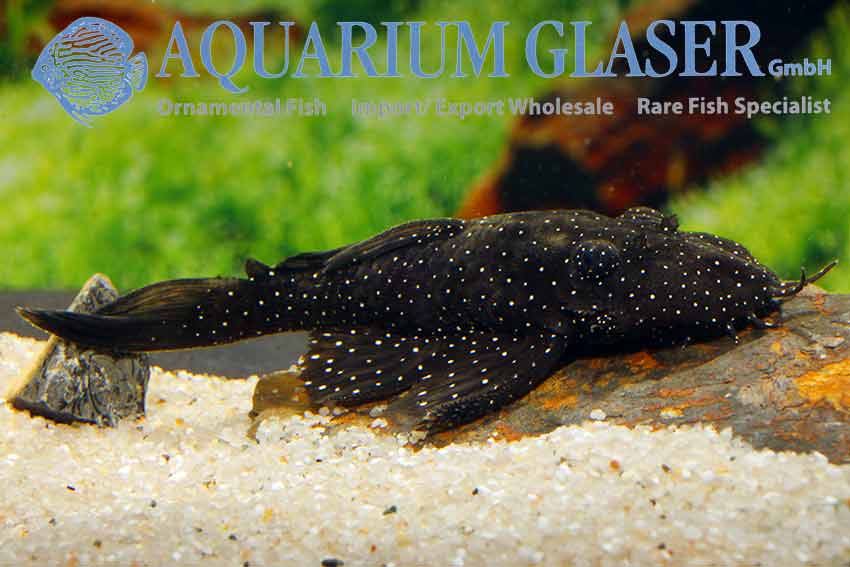
For our customers: the fish have code 26-480-L 181X-1 on our stocklist. Please note that we exclusively supply the wholesale trade.
Text & photos: Frank Schäfer
Three new Chaetostoma from Peru!
Sometimes we are really lucky and months of hard work and planning find an end in a successful importation of new or very rare species. This happend recently and a shipment from Peru contained not less than three new and spectacular Chaetostoma! These fish are at least new for the hobby and possibly also new to science.

The most spectacular is for sure Chaetostoma sp. “Tiger”, which has a whitish to bright yellow pattern on a dark brown to black ground.

Chaetostoma sp. “Tingo Red” is quite similar, but it shows a very intensive orange red coloration of the caudal fin, a more metallic basic colour and a less contrasting pattern.

Finally, Chaetostoma sp. “Pisqui River”, also quite similar to the preceeding, but with a stronger pattern.
All varieties are quite variable regarding coloration and very similar in body shape, so it is possible that all belong to the same species. Our largest specimens are around 8 cm long and obviously males. That means they are fully grown or at least sexually mature. Females stay smaller and are less colorful. All species of Chaetostoma have proofed so far to be easy to keep and to breed. In general they have to be kept like Ancistrus, but prefer a bit stronger current and temperatures between 20-24°C. So hopefully these magnificent creatures will become established in the hobby.

For our customers: Chaetostoma sp. Tiger” has code 214844, Ch. sp. “Tingo Red” 214824 and Ch. sp. “Pisqui River” 214874 on our stocklist. Please note that we exclusively supply the wholesale trade.
Lexicon: Chaetostoma: ancient Greek, means “bristle mouth”.
Suggestion of a common name: does not seam to make sense currently.
Text & Photos: Frank Schäfer
Just in: Bred Hypancistrus sp. L399

Hypancistrus sp. L399 is one of the smaller species of the genus. The maximum length reported is approx. 8 cm. Like so many of its congeneers this fish is highly variable regarding the pattern. We have received right now a few specimens of this rare beauty from a German breeder, which are currently 4-5 cm long. The photo depicts one of the parent fish.


For our customers: the fish have code 26480-L399x-2 on our stocklist. Please note that we exclusively supply the wholesale market.
Text & photos: Frank Schäfer
Big from Peru!
As last week 2 very huge boxes arrived from Peru the whole Aquarium Glaser team was full of excitement to their content. Then two giant specimens of the giant Panaques LDA 65 appeared in the best condition. With a length of about 60 cm, they should be mature, for “normal” tanks they are obviously not suitable. In very large tanks, they are certainly interesting fish, and could be for example socialized with stingrays or large predatory characins or catfishes.







